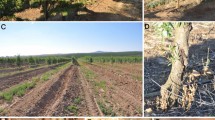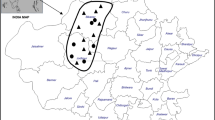Abstract
Fusariosis, one of the phytosanitary problems found in rubber producing areas in the northwest of the state of São Paulo, is a disease that affects the bark of the adult plants, affecting the exploitation of latex. The typical symptoms appear as cracks in the bark that expand from the rootstock towards the tapping panel, causing a drying of the latex flux in the injured region, impeding latex tapping. Due to the recent incidence of this disease in rubber plantations, the goal of this study was to characterize the Fusarium associated with symptomatic rubber tissue in three different locations in the state of São Paulo. In order to identify Fusarium species, pathogenicity, morphological, cultural and molecular studies were carried out. A total of 51 isolates were obtained and separated into three groups based on macroconidium morphology, presence or absence of sporodochia, types of chlamydospores, formation of phialides and conidiogenesis of microconidia and mesoconidia, mycelial growth rate and coloring of the colonies. These groups were corroborated using DNA sequence information for five different genetic loci, and were subsequently recognized as Fusarium oxysporum, F. incarnatum and F. decemcellulare. Our results further showed that all 51 of the Fusarium isolates recovered were pathogenic to rubber tree seedlings of RRIM 600 standard clone. This study also reports for the presence of F. oxysporum and F. incarnatum in rubber plantations in the state of São Paulo and in Brazil.




Similar content being viewed by others
References
Appel, D. J., & Gordon, T. R. (1996). Relationships among pathogenic and nonpathogenic isolates of fusarium oxysporum based on the partial sequence of the intergenic spacer region of the ribosomal DNA. Molecular Plant-Microbe Interactions, 9, 125–138.
Cheng, Y., Zhao, W., Lin, R., Yao, Y., Yu, S., Zhou, Z., Zhang, X., Gao, Y., & Huai, W. (2019). Fusarium species in declining wild apple forests on the northern slope of the Tian Shan Mountains in North-Western China. Forest Pathology, 49, 1–20. https://doi.org/10.1111/efp.12542.
Dória, K.M.A.B.V.S. (2012) Caracterização morfológica, cultural, molecular e enzimática de isolados de Fusarium spp. de seringueira. Dissertation, Universidade Estadual Paulista, Faculdade de Ciências Agronômicas, Botucatu.
Ebadi, M., & Riahi, H. (2013). Morphological and genetic variation of the fusarium semitectum isolates associated with cereal grains using RAPD markers. International Journal of Agriculture and Biosciences, 2, 327–332.
Fernandez, M. R. (1993). Manual para laboratório de fitopatologia. Passo Fundo: EMATER – CNPT.
Gasparotto, L., Santos, A. F., Pereira, J. C. R., Ferreira, F. A. & Furtado, E. L. (2012). Doenças do caule. (In Gasparotto, L. & Pereira, J. C. R. (Eds.), Doenças da Seringueira no Brasil (pp. 177-215). Brasília-DF: Embrapa.)
Glass, N. L., & Donaldson, G. C. (1995). Development of primer sets designed for use with the PCR to amplify conserved genes from filamentous Ascomycetes. Applied and Environmental Microbiology, 61, 1323–1330.
Gomes, J. J. (1981). Estudo anatômico do xilema secundário das espécies de Hevea da Amazônia brasileira. In Dissertation. Paraná, Curitiba: Universidade Federal do.
Gonçalves, P. S., Martins, A. L. M., Furtado, E. L., Sambugaro, R., Ottati, E. L., Ortolani, A. A., & Godoy Júnior, G. (2002). Desempenho de clones de seringueira da série IAC 300 na região do planalto de São Paulo. Pesquisa Agropecuária Brasileira, 37, 131–138.
Huang, G. X., Zhou, X. M., Liu, X. B., Cai, J. M., & Li, B. X. (2016). First report of rubber tree gummosis disease caused by fusarium solani in China. Plant Disease, 100, 1788–1788.
Ibge, Instituto Brasileiro de Geografia e Estatística. (2019). Produção Agrícola Municipal., 2018 Retrieved November 12, 2019, from: https://www.ibge.gov.br/estatisticas/economicas/agricultura-e-pecuaria/9117-producao-agricola-municipal-culturas-temporarias-e-permanentes.html?=&t=resultados.
Jiang, G., Wang, Y., Zhou, M., & Li, G. (2015b). Isolation and identification of fungus causing collar rot disease of rubber tree. Agricultural Science & Technology, 16, 529–529.
Jiang, G. Z., Liu, J., & Li, G. H. (2015a). Two new diseases on Hevea rubber trees caused by fusarium. Journal of Southwest University, 37, 42–47.
Kawabe, M., Kobayashi, Y., Okada, G., Yamaguchi, I., Teraoka, T., & Arie, T. (2005). Three evolutionary lineages of tomato wilt pathogen, fusarium oxysporum f. sp. lycopersici, based on sequences of IGS, MAT1, and pg1, are each composed of isolates of a single mating type and a single or closely related vegetative compatibility group. Journal of General Plant Pathology, 71, 263–272. https://doi.org/10.1007/s10327-005-0203-6.
Kimura, M. (1980). A simple method for estimating evolutionary rates of base substitutions through comparative studies of nucleotide sequences. Journal of Molecular Evolution, 16, 111–120.
Komada, H., Ogawa, K., & Aoki, T. (2011). Fusarium. Tokyo: Zenkoku Nouson Kyoiku Kyokai (in Japanese).
Leslie, J. F., & Summerell, B. A. (2006). The fusarium laboratory manual. EUA: Blackwell Willey.
Li, B. X., Shi, T., Liu, X. B., Lin, C. H., & Huang, G. X. (2014). First report of rubber tree stem rot caused by fusarium oxysporum in China. Plant Disease, 98, 1008–1008.
Lombard, L., Sandoval-Denis, M., Lamprecht, S. C., & Crous, P. W. (2019). Epitypification of fusarium oxysporum – Clearing the taxonomic chaos. Persoonia, 43, 1–47. https://doi.org/10.3767/persoonia.2019.43.01.
Mirete, S., Vázquez, C., Mulè, G., Jurado, M., & González-Jaén, M. T. (2004). Differentiation of fusarium verticillioides from Banana fruits by IGS and EF-1α sequence analyses. European Journal of Plant Pathology, 110, 515–523. https://doi.org/10.1023/b:ejpp.0000032391.38512.f8.
Nhung, N. P., Thu, P. Q., Dell, B., & Chi, N. M. (2018). First report of canker disease in Dalbergia tonkinensis caused by fusarium lateritium and fusarium decemcellulare. Australasian Plant Pathology, 47, 317–323. https://doi.org/10.1007/s13313-018-0562-z.
O’Donnell, K., Kistler, H. C., Cigelnik, E. & Ploetz, R. C. (1998). Multiple evolutionary origins of the fungus causing Panama disease of banana: Concordant evidence from nuclear and mitochondrial gene genealogies. Proceedings of the National Academy of science of the United States of America, 95, 2044–2049.
O'Donnell, K., Sutton, D. A., Rinaldi, M. G., Sarver, B. A. J., Balajee, S. A., Schroers, H.-J., Summerbell, R. C., Robert, V. A. R. G., Crous, P. W., Zhang, N., Aoki, T., Jung, K., Park, J., Lee, Y.-H., Kang, S., Park, B., & Geiser, D. M. (2010). Internet-accessible DNA sequence database for identifying fusaria from human and animal infections. Journal of Clinical Microbiology, 48, 3708–3718.
Oliveira, J. A. (1991). Efeito do tratamento fungicida em sementes no controle de tombamento de plântulas de pepino (Cucumis sativus L.) e pimentão (Capsicum annum L.). Dissertation, Universidade Federal de Lavras, Lavras.
Rural, G. (2013). June. Globo Rural: Pesquisadores descobrem fórmula que combate fungo na seringueira Retrieved from http://g1.globo.com/economia/agronegocios/noticia/2013/06/pesquisadores-apontam-formula-que-combate-fungo-na-seringueira.html.
Saitoh, K., Togashi, K., Arie, T., & Teraoka, T. (2006). A simple method for a mini-preparation of fungal DNA. Journal of General Plant Pathology, 72, 348–350.
Schoch, C. L., Seifert, K. A., Huhndorf, S., Robert, V., Spouge, J. L., Levesque, C. A., & Chen, W. (2012). Nuclear ribosomal internal transcribed spacer (ITS) region as a universal DNA barcode marker for Fungi. Proceedings of the National Academy of Sciences, 109, 6241–6246.
Summerell, B. A., & Leslie, J. F. (2011). Fifty years of fusarium: How could nine species have ever been enough? Fungal Diversity, 50, 135–144. https://doi.org/10.1007/s13225-011-0132-y.
Summerell, B. A., Leslie, J. F., Liew, E. C. Y., Laurence, M. H., Bullock, S., Petrovic, T., Bentley, A. R., Howard, C. G., Peterson, S. A., Walsh, J. L., & Burgess, L. W. (2011). Fusarium species associated with plants in Australia. Fungal Diversity, 46, 1–27. https://doi.org/10.1007/s13225-010-0075-8.
Tamura, K., Stecher, G., Peterson, D., Filipski, A., & Kumar, S. (2013). MEGA6: Molecular evolutionary genetics analysis version 6.0. Molecular Biology and Evolution, 30, 2725–2729.
Thompson, J. D., Gibson, T. J., Plewniak, F., Jeanmougin, F., & Higgins, D. G. (1997). The Clustal_X windows interface: Flexible strategies for multiple sequence alignment aided by quality analysis tools. Nucleic Acids Research, 25, 4876–4882.
Wang, M. M., Chen, Q., Diao, Y. Z., Duan, W. J., & Cai, L. (2019). Fusarium incarnatum-equiseti complex from China. Persoonia, 43, 70–89. https://doi.org/10.3767/persoonia.2019.43.03.
White, T. J., Bruns, T. D., Lee, S. B. & Taylor, J. W. (1990). Amplification and direct sequencing of fungal ribosomal RNA genes for phylogenetics. (in M.a. Innis, D.H. Gelfand, J.J. Sninsky, & T.J. White (Eds.), PCR protocols: A guide to methods and applications. (pp. 315-322). New York: Academic press.).
Xia, J. W., Sandoval-Denis, M., Crous, P. W., Zhang, X. G., & Lombard, L. (2019). Numbers to names - restyling the fusarium incarnatum-equiseti species complex. Persoonia, 43, 186–221. https://doi.org/10.3767/persoonia.2019.43.05.
Acknowledgments
We thank to Prof. Dr. Tsutomu Arie and all his team for guidance and collaboration in morphological and molecular studies and for giving in, kindly, the Fo304 and F880621a-1 isolates for the pathogenicity study, we also thank to Capes (Coordination for the Improvement of Higher Education Personnel) and Jasso (Japan Student Services Organization) by the financial support and to CNPq (National Council for Scientific and Technological Development).
Author information
Authors and Affiliations
Corresponding author
Ethics declarations
Disclosure of potential conflicts of interest
This manuscript is part of a doctoral studies developed by the principal author (Marilia Pizetta), which is the reason it was published on the University’s platform, available at the following website:
https://repositorio.unesp.br/bitstream/handle/11449/151443/pizetta_m_dr_bot_int.pdf?sequence=4&isAllowed=y (in Portuguese). In addition, this manuscript has not been submitted to any other Journal so far.
Research involving human participants and/or animals
Our research did not have use the human or animal participants.
Supplementary Information
ESM 1
(DOCX 570 kb)
Rights and permissions
About this article
Cite this article
Pizetta, M., Pierozzi, C.G., Ayukawa, Y. et al. Fusariosis in rubber tree: pathogenic, morphological, and molecular characterization of the causal agent. Eur J Plant Pathol 161, 769–782 (2021). https://doi.org/10.1007/s10658-021-02362-0
Accepted:
Published:
Issue Date:
DOI: https://doi.org/10.1007/s10658-021-02362-0




